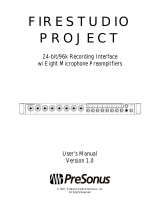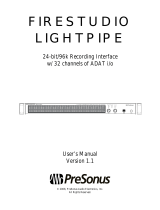• StudioLive Series III Rackmount Mixer Owner’s Manual. Use this reference
guide to understand all the hardware functions on your StudioLive Series
III rackmount mixer (StudioLive 32R, StudioLive 24R, StudioLive 16R).
• StudioLive AI-Series Console Mixer Owner’s Manual. Use this reference
guide to understand all the hardware functions on your StudioLive AI-Series
console mixer (StudioLive 32.4.2AI, StudioLive 24.4.2AI, StudioLive 16.4.2AI).
• StudioLive AI-Series Rackmount Mixer Owner’s Manual. Use this reference
guide to understand all the hardware functions on your StudioLive AI-
Series rackmount mixer (StudioLive RM/RML32, StudioLive RM/RML16).
Software Guides:
• Networking for StudioLive Remote Control. This guide will
assist you in creating a LAN network to remote control your
StudioLive from a computer, tablet, or mobile device.
• UC Surface Reference Manual. This guide describes the features
and functions UC Surface with every StudioLive mixer model.
• QMix-UC Reference Manual. This guide describes the features and
functions of QMix-UC with every StudioLive mixer model.
• Capture 2 Reference Manual. Included with StudioLive mixers
is Capture, a digital-audio multitrack-recording application
designed to make recording quick and easy.
• Studio One Integration Reference Manual. Studio One Artist is
included with every StudioLive mixer. In addition to being a powerful
DAW, Studio One provides unique routing and integration features.
This manual will help you get the most from your StudioLive
mixer when used with Studio One or Studio One Artist.
Additional Resources:
• StudioLive Series III AVB Networking Guide. This manual covers advanced
AVB audio networking configuration for the StudioLive Series III mixers.
• StudioLive Series III Stage box Mode Addendum. The StudioLive
Series III rackmount mixers (StudioLive 32R, StudioLive 24R, StudioLive
16R) can be used as advanced stageboxes for StudioLive Series III
console mixers (StudioLive 32, StudioLive 24, StudioLive 16).
• StudioLive Series III Studio One DAW Control Addendum. StudioLive
Series III console mixers (StudioLive 32, StudioLive 24, StudioLive
16) can be used to control Studio One and Studio One Artist.
1.3 Technical Support
Many technical issues can arise when using a standard computer as a digital audio
workstation (DAW). PreSonus can only provide support for issues that directly
relate to the StudioLive mixer, UC Surface, QMix-UC, Capture, and Studio One.
PreSonus does not provide support for computer hardware, iOS
hardware, Android devices, wireless networks, operating systems, and
non-PreSonus hardware and software, and it may be necessary to
contact the manufacturer of these products for technical support.
Please check our Web site (www.presonus.com) regularly for
software information and updates, firmware updates, and
support documentation for frequently asked questions.
Online technical support is available at http://support.presonus.
com, as well as from your http://my.presonus.com.
Advanced troubleshooting guides can be found at http://answers.presonus.com/.





















